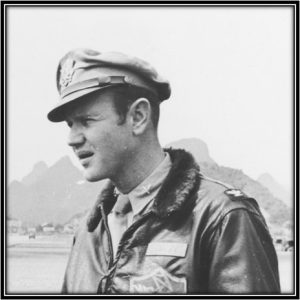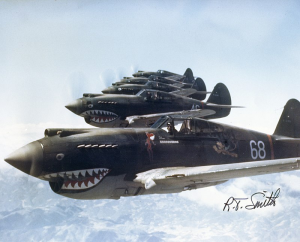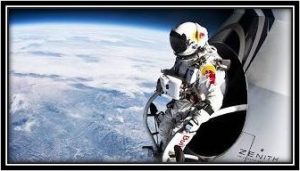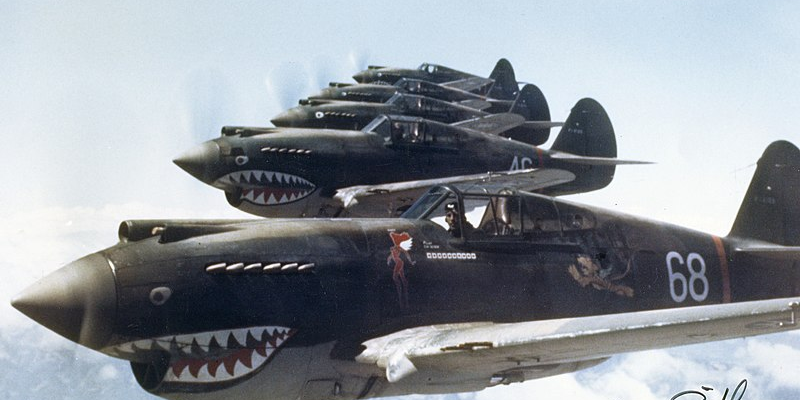An Aviation History Fourfer
Contributor: Barry Fetzer
Sources: History.com, ESPN, San Diego Air and Space Museum, Jay Nemeth/Red Bull
In honor of the 95 degrees we’re experiencing in the Sandhills, welcome to a sizzling “hot” mid-July aviation history “fourfer” (fourfer the price of one) starting with today, July 20th, remembering the anniversary of first man on the moon back in 1969. We’ll travel even further to the past in our time machine and transition to a week ago, way back on July 13, 1915 honoring the birth of one of the Flying Tigers’ best. Then we’ll take our time machine forward again to July 1943 during WWII, and finally we’ll “fly” forward in time again to three days ago on July 17, 2025. And inside this fourfer: a notable birth and a tragic death: the way of our world. Out with some of us and in with some of us to replace those who move out.
Fourfer #1. According to History.com and downloaded today from https://www.history.com/this-day-in-history/july-20/armstrong-walks-on-moon. On July 20, 1969 at 10:56 p.m. EDT, American astronaut Neil Armstrong, 240,000 miles from Earth, speaks these words to more than a billion people listening at home: “That’s one small step for a man, one giant leap for mankind.” Stepping off the lunar module Eagle, Armstrong became the first human to walk on the surface of the moon.
The American effort to send astronauts to the moon has its origins in a famous appeal President John F. Kennedy made to a special joint session of Congress on May 25, 1961: “I believe this nation should commit itself to achieving the goal, before this decade is out, of landing a man on the moon and returning him safely to the Earth.” At the time, the United States was still trailing the Soviet Union in space developments, and Cold War-era America welcomed Kennedy’s bold proposal.
In 1966, after five years of work by an international team of scientists and engineers, the National Aeronautics and Space Administration (NASA) conducted the first unmanned Apollo test flight, trying out the structural integrity of the proposed launch vehicle and spacecraft combination. Then, on January 27, 1967, tragedy struck at Cape Canaveral Space Force Station in Cape Canaveral, Florida, when a fire broke out during a manned launch-pad test of the Apollo spacecraft and Saturn rocket. Three astronauts were killed in the fire.
Despite the setback, NASA and its thousands of workers forged ahead, and in October 1968, Apollo 7, the first manned Apollo mission, orbited Earth and successfully tested many of the sophisticated systems needed to conduct a moon journey and landing. In December of the same year, Apollo 8 took three astronauts around the far side of the moon and orbited it 10 times before returning, and in March 1969 Apollo 9 tested the lunar module for the first time while in Earth orbit. Then in May, the three astronauts of Apollo 10 took the first complete Apollo spacecraft in 31 orbits around the moon in a dry run for the scheduled July landing mission.
At 9:32 a.m. on July 16, with the world watching, Apollo 11 took off from Kennedy Space Center with astronauts Neil Armstrong, Edwin Aldrin Jr., and Michael Collins aboard. Armstrong, a 38-year-old research pilot, was the commander of the mission. After traveling 240,000 miles in 76 hours, Apollo 11 entered a lunar orbit on July 19. The next day, at 1:46 p.m., the lunar module Eagle, manned by Armstrong and Aldrin, separated from the command module, where Collins remained. Two hours later, the Eagle began its descent to the lunar surface, and at 4:18 p.m. the craft touched down on the southwestern edge of the Sea of Tranquility. Armstrong immediately radioed to Mission Control in Houston,
At 10:39 p.m., five hours ahead of the original schedule, Armstrong opened the hatch of the lunar module. As he made his way down the lunar module’s ladder, a television camera attached to the craft recorded his progress and beamed the signal back to Earth, where hundreds of millions watched in great anticipation. At 10:56 p.m., Armstrong spoke his famous quote, which he later contended was slightly garbled by his microphone and meant to be “that’s one small step for a man, one giant leap for mankind.” He then planted his left foot on the gray, powdery surface, took a cautious step forward, and humanity had walked on the moon.
“Buzz” Aldrin joined him on the moon’s surface at 11:11 p.m., and together they took photographs of the terrain, planted a U.S. flag, ran a few simple scientific tests, and spoke with President Richard M. Nixon via Houston. By 1:11 a.m. on July 21, both astronauts were back in the lunar module and the hatch was closed. The two men slept that night on the surface of the moon, and at 1:54 p.m. the Eagle began its ascent back to the command module. Among the items left on the surface of the moon was a plaque that read: “Here men from the planet Earth first set foot upon the moon–July 1969 A.D–We came in peace for all mankind.”
At 5:35 p.m., Armstrong and Aldrin successfully docked and rejoined Collins, and at 12:56 a.m. on July 22 Apollo 11 began its journey home, safely splashing down in the Pacific Ocean at 12:51 p.m. on July 24.
There would be five more successful lunar landing missions, and one unplanned lunar swing-by, Apollo 13. The last men to walk on the moon, astronauts Eugene Cernan and Harrison Schmitt of the Apollo 17 mission, left the lunar surface on December 14, 1972. The Apollo program was a costly and labor-intensive endeavor, involving an estimated 400,000 engineers, technicians, and scientists, and costing $24 billion (close to $100 billion in today’s dollars). The expense was justified by Kennedy’s 1961 mandate to beat the Soviets to the moon, and after the feat was accomplished, ongoing missions lost their viability.
Fourfer#2: Today in Aviation History: Birth of Flying Tiger Ace David Lee “Tex” Hill
Downloaded on July 19, 2025 from: https://vintageaviationnews.com/warbird-articles/today-in-aviation-history/today-in-aviation-history-birth-of-flying-tiger-ace-david-lee-tex-hill.html.
On July 13, 1915, legendary Flying Tiger ace David Lee “Tex” Hill was born in Gwangju, Korea. A triple ace with 12¼ confirmed victories, Hill rose to fame flying P-40 Warhawks with the American Volunteer Group during World War II. From his early days in Texas to commanding the U.S.’s first operational jet fighter group, Hill’s remarkable aviation career spanned two major conflicts and earned him a place among America’s most celebrated fighter pilots.
By Austin Hancock/Published July 13, 2025. Mr. Hancock is a commercial Pilot, CFI, and Museum Entrepreneur, with a subject focus on WWII Aviation. I am dedicated to building flight experience so I can fly WWII Fighters, such as the P-51 Mustang, for museums and airshows, and in the USAF Heritage Flight. I lead and run the Pennington Flight Memorial, to honor local MIA Tuskegee Airman F/O Leland “Sticky” Pennington

Flying Tigers pilot David “Tex” Hill in 1944. Courtesy of the San Diego Air and Space Museum.
On this day in aviation history, 110 years ago (July 13, 1915), legendary American fighter pilot David Lee “Tex” Hill was born. A triple ace, Hill is officially credited with 12¼ aerial victories during his military career, which spanned World War II and the Korean War. He is best remembered as one of the elite American Volunteer Group (AVG) pilots—better known as the Flying Tigers. Hill’s story began in Gwangju, Korea, then under Japanese rule. He was born into a family of Presbyterian missionaries, the youngest of four children. When he was just 15 months old, the Hill family returned to the United States and settled in San Antonio, Texas.
He attended San Antonio Academy, graduating in 1928, and later enrolled at the McCallie School in Chattanooga, Tennessee, where he won the state middleweight boxing championship in 1934. Hill went on to graduate from Austin College in 1938. His passion for aviation took root early—his first flight occurred at Winburn Field when he and a friend skipped church and were taken for a ride in a Travel Air 4000 piloted by Marion P. Hair.
In 1938, Hill enlisted in the U.S. Navy and earned his wings as a Naval Aviator in November 1939. He initially flew Douglas TBD Devastators and Vought SB2U Vindicators with a dive-bomber squadron. In 1941, Hill was recruited alongside other Navy, Marine Corps, and Army pilots to join the American Volunteer Group in China. Flying the Curtiss P-40 Warhawk under the leadership of Claire Chennault, Hill quickly distinguished himself as one of the top aces of the AVG.

3rd Squadron Hell’s Angels, Flying Tigers, over China, photographed in 1942 by AVG pilot Robert T. Smith. Public domain.
He scored his first two kills on January 3, 1942, downing a pair of Nakajima Ki-27 “Nate” fighters over Tak, Thailand. By February, he had reached ace status. When the Flying Tigers were disbanded in the summer of 1942, “Tex” Hill had achieved double-ace status with 12¼ confirmed victories. In 1944, he was appointed commander of the 412th Fighter Group—the U.S. military’s first operational jet fighter unit—flying the Bell P-59 Airacomet and Lockheed P-80 Shooting Star.
During the Korean War era, Hill continued to serve with the Texas Air National Guard and ultimately retired as a brigadier general in the U.S. Air Force Reserve. His valor and leadership earned him numerous honors, including the Distinguished Service Cross and the Air Medal. David Lee “Tex” Hill passed away on October 11, 2007, at the age of 92. His legacy as one of America’s most accomplished and respected fighter pilots endures, and his story continues to inspire generations of aviators.
Fourfer #3. According to History.com and downloaded from https://www.history.com/this-day-in-history/july-19/america-bombs-rome, on July 19, 1943, the United States bombed railway yards in Rome in an attempt to break the will of the Italian people to resist—as Hitler lectures their leader, Benito Mussolini, on how to prosecute the war further.
On July 16, President Franklin Roosevelt and British Prime Minister Winston Churchill appealed to the Italian civilian population to reject Mussolini and Hitler and “live for Italy and civilization.” As an “incentive,” American bombers raided the city, destroying its railways. Panic broke out among the Romans. Convinced by Mussolini that the Allies would never bomb the holy city, civilians poured into the Italian capital for safety. The bombing did more than shake their security in the city—it shook their confidence in their leader.
The denizens of Rome were not alone in such disillusion. In a meeting in northern Italy, Hitler attempted to revive the flagging spirits of Il Duce, as well as point out his deficiencies as a leader. Afraid that Mussolini, having suffered successive military setbacks, would sue for a separate peace, leaving the Germans alone to battle it out with Allied forces along the Italian peninsula, Hitler decided to meet with his onetime role model to lecture him on the manly art of war. Mussolini remained uncharacteristically silent during the harangue, partly due to his own poor German (he would request a translated synopsis of the meeting later), partly due to his fear of Hitler’s response should he tell the truth—that Italy was beaten and could not continue to fight.
Mussolini kept up the charade for his German allies: Italy would press on. But no one believed the brave front anymore. Just a day later, Hitler secretly ordered Field Marshal Erwin Rommel to take command of the occupied Greek Islands, better to “pounce on Italy” if and when Mussolini capitulated to the United States. But within a week, events would take a stunning turn.
Fourfer #4. Stratospheric skydiver Felix Baumgartner dies in paraglider crash
Jul 18, 2025, 10:52 AM ET

Baumgartner preparing to leap. Courtesy FILE/Jay Nemeth/Red Bull Content Pool.
According to the Associated Press and ESPN and downloaded July 18, 2025 from: https://www.espn.com/espn/story/_/id/45765034/stratospheric-skydiver-felix-baumgartner-dies-paraglider-crash:
MILAN — Extreme athlete Felix Baumgartner, the first skydiver to fall faster than the speed of sound during a 24-mile leap through the stratosphere more than a decade ago, died in a crash Thursday (July 17, 2025) along the eastern coast of Italy, according to an official. He was 56.
Italian firefighters who responded said a paraglider crashed into the side of a swimming pool in the city of Porto Sant’Elpidio.
The city’s mayor, Massimiliano Ciarpella, confirmed Baumgartner’s death in a social media post.
“Our community is deeply affected by the tragic disappearance of Felix Baumgartner, a figure of global prominence, a symbol of courage and passion for extreme flight,” the mayor said.
Felix Baumgartner, in 2012, became the first human to break the sound barrier with only his body, reaching 843.6 mph in his pressurized suit during a 9-mile descent from a capsule hoisted more than 24 miles above the Earth by a helium balloon. FILE/Jay Nemeth/Red Bull Content Pool
Baumgartner, known as “Fearless Felix,” stunned the world in 2012 when he became the first human to break the sound barrier with only his body. He wore a pressurized suit and jumped from a capsule hoisted more than 24 miles (39 kilometers) above Earth by a giant helium balloon over New Mexico.
The Austrian, who was part of the Red Bull Stratos team, topped out at 843.6 mph — the equivalent of 1.25 times the speed of sound — during a nine-minute descent.
“When I was standing there on top of the world, you become so humble, you do not think about of breaking records anymore, you do not think of about gaining scientific data. The only thing you want is to come back alive,” he said after landing in the eastern New Mexico desert.
The altitude he jumped from also marked the highest ever for a skydiver, shattering the previous record set in 1960 by Joe Kittinger, who served as an adviser to Baumgartner during his feat.
Baumgartner’s altitude record stood for two years until Google executive Alan Eustace set new marks for the highest free-fall jump and greatest free-fall distance.
In 2012, millions watched YouTube’s livestream as Baumgartner coolly flashed a thumbs-up when he came out of the capsule high above Earth and then activated his parachute as he neared the ground, lifting his arms in victory after he landed.
Baumgartner, a former Austrian military parachutist, made thousands of jumps from planes, bridges, skyscrapers and famed landmarks around the world, including the Christ the Redeemer statue in Brazil.
In 2003, he flew across the English Channel in a carbon fiber wing after being dropped from a plane.
In recent years, he performed with The Flying Bulls as a helicopter stunt pilot in shows across Europe.
Baumgartner said after his record-breaking jump in 2012 that traveling faster than sound is “hard to describe because you don’t feel it.”
“Sometimes we have to get really high to see how small we are,” he said.
Onward and upward!
Sources: History.com, ESPN, San Diego Air and Space Museum, Jay Nemeth/Red Bull







